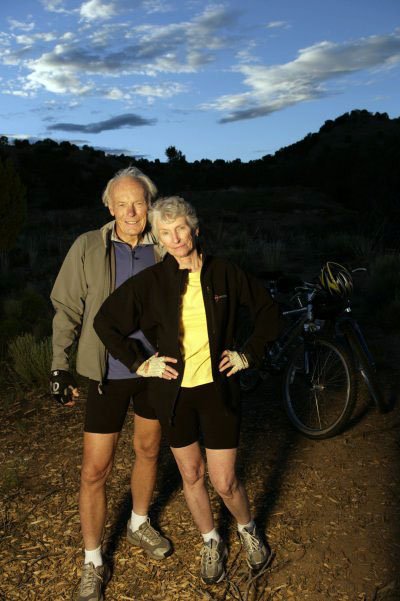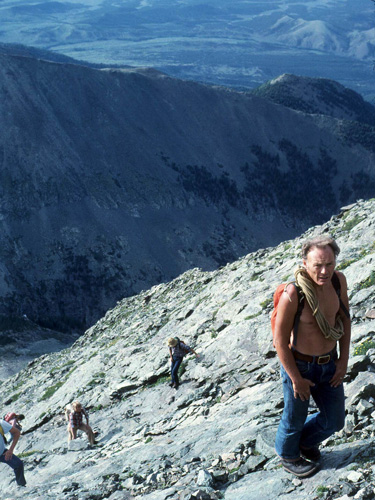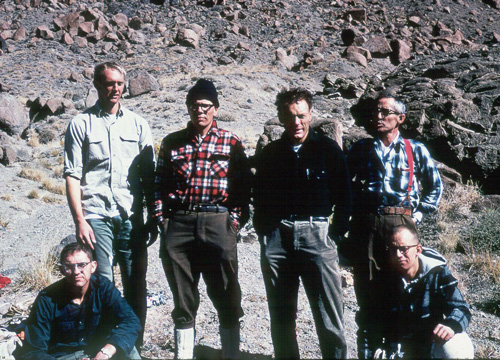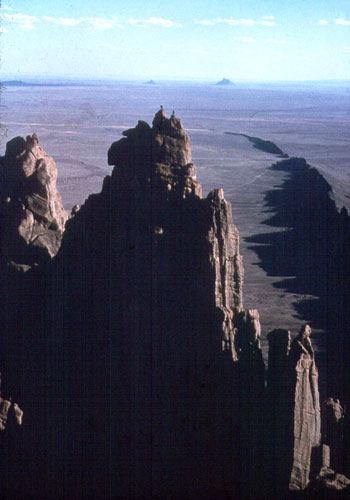Don Liska is unquestionably one of
LAM's most experienced mountaineers and adventurers. He has been a
member of the American Alpine Club for many years, and is a
"Lifetime" member of the Los Alamos Mountaineers. This Bio
highlights only a few of Don's many mountaineering attempts and accomplishments.
"Alice and I started climbing at Devil’s Lake, Wisconsin in 1952
using hemp ropes, tennis shoes, forged pitons and GI surplus
steel carabiners. To give a flavor of those early days, consider
that the Sierra Club climbers who first summited Shiprock in
1939 did not know the prussik knot. We were also primitive. We
did not use harnesses or helmets and much of our gear had to be
ordered from Europe. However, the audacity of youth reigned then
as it does today and after only a few weeks on the short
quartzite pitches of Devil’s Lake a few of us set out for
Colorado to climb Stettner’s Ledges (5.7) on the east face of
Longs Peak, at that time considered a very difficult climb. This
was the period when the first 8000er, Annapurna 1, had just been
climbed by the French and Everest was about to fall to the
British. Furthermore, the movie “Shane” revealed the magnificent
Tetons to America’s astonished eyes. These were formative years
for young climbers. A draftee during the Korean war period,
Alice and I were married and torn from our mid-west roots. After
discharge we moved into a 29 foot house trailer in Los Angeles.
Climbing and travel became the pattern of our lives, culminating
after 50 years in 12 major expeditions and numerous first
ascents, many with noted climbers such as Mike Sherrick, Harvey
Carter, Leif Patterson, Fred Becky, Andy Harvard, Eric Bjornstad
and others plus our own local greats. Our best climbs over the
years were in Europe, South America, Canada and Alaska though
Asia and Russia also entered into the climbing picture with some
significant successes."
Don Liska.

Don and Alice
enjoying an evening mountain bike ride.
Don Liska came to Los Alamos in 1966 and climbed in the Brazos
as late as 2003, a 38-year period. Don recalls that "My first
climb with the Mountaineers occurred only 2 weeks after we
arrived in Los Alamos in June, 1966. We climbed Easy Ridge.
Emily Willbanks and Ken Ewing were there. We did overnights in
those early days and slept out near the Brazos Lodge. It was a
pretty big deal, going to the Brazos in the 60's. One could not
buy gas in Los Alamos as the only station closed on weekends.
You could get a little gas from the police but you had to have
enough to reach Espanola. Sometimes people would run out on the
way." Don Liska, Dick Ingram, George Goedecke, and Paul Wholt
did the first ascent of the Great Couloir by the Direct Finish
(17 pitches) later in 1966.

The Main Brazos Cliffs as seen from the South.
Photo by
Aaron Miller via Mountain PROJECT
Brazos
Explorations:
Len Margolin came to Los Alamos in 1969 and quickly became one
of the club's strongest climbers. He said that climbers like
himself and Don Liska "had the low-hanging fruit." They could do
everything for the first time and didn't have to worry about
style, etc. Don said that "We got so familiar with the Brazos we
did all sorts of obscure 'firsts' and tied all routes together
with hair-raising traverses. We would bring back the
licorice-smelling plant on those cliffs and keep it in a jar at
home for weeks, always reminding us of 'unfinished work' at the
Brazos. On one juvenile stunt, Larry Dauelsberg, Ernie Anderson,
and I dashed out to the Brazos in June 1968 to do the 'Direct
Start to Easy Ridge' which added 5 pitches to the standard
10-pitch route and made Easy Ridge one of the longer climbs on
the face. The juvenile part was a rumor we heard that some other
local climber had his mind on that route. It shows how
determined LAM climbers were in those days to do new things at
the Brazos. Several of us also did winter explorations of the
Brazos cliffs and tried dead-winter ascents. On one attempt on
Easy Ridge we were three pitches into the route when a ton of
ice came down and chopped the belay tree off at the five foot
level. This made us stop and immediately descend."
Don recalls that "On the 1968
first ascent of Gothic Arches Buttress we took four weeks to
work out the route, returning to Los Alamos between weekends. On
the last weekend, near the top and climbing by moonlight, I
zippered out a string of direct aid pitons and was caught on a
30' fall by my buddies. Gothic Arches was a high caliber route
in those days, rated 5.7 and 22 pitches. Why did we climb by
moonlight? Well, to have a comfortable bivouac at the top of
course. Instead we had an uncomfortable bivouac on the face. I
should at least have used hero loops and a swami belt. Seat
harnesses were rare in those days and individually wrapped out
of 1" tubular webbing."
Mexican Volcanos: Don
also initiated several trips to the Mexican volcanos, which were
all virgin territory for the Mountaineers. At Christmas time in
1967, Don and Alice Liska and Dave and Faye Brown went to Mexico
to enjoy the holiday season and climb Popocatepl and
Ixtaccihuatl. Don wrote an unpublished article in 1971 on
"Climbing the Three Mexican Volcanos." In the early 1970's,
Larry Campbell, Carroll Mills, and other Mountaineers joined Don
on several trips to climb Popocatepl, Ixtaccihuatl, and Orizaba.
Don
and Larry Campbell led a Mountaineers' trip to Baja
California to climb Picacho del Diablo in 1973. Don says that
"This was a fine trip. It had Gerry Roach on it. Roach later
became a well known name in hard-core climbing and authored a
guide to the Colorado Mountains. On our way in we encountered a
'bolt ladder'--namely a carpenter's ladder slung from a bolt on
the granite wall above the big waterfall. On this trip Carroll
Mills decided he would survive the 5-day climb on 10 pounds of
roasted soy beans and water. Fortunately, there were a couple of
excellent gourmet climbers on the trip so Carroll was not overly
tested. The climb was successful."
Early Colorado Climbs:
Don recalls that some club climbers used to go into New York
basin with Ernie Anderson and George Bell. "These were small
scheduled LAM outings. In the 1960's this was very wild terrain
and most climbers only went to Chicago Basin. There was no trail
and a lot of heavy side-hilling and bushwhacking to get in
there. Inside the basin were Pigeon Peak and Turret. Pigeon is
13972', the finest peak in the Ruby Range, fortunately 28' short
of being a 14'er which saves it from the crowds. Of course you
could also climb Eolus from New York basin but few people
bothered since Chicago Basin was so popular. During one of our
climbs on Pigeon the rappel rope jammed and I had to do a
hand-over-hand to retrieve it. It was a dangerous and foolish
thing to do since had it come loose I would have been killed.
Pigeon was a fine technical climb and to protect the approach to
New York Basin we always swept our tracks clean with a branch
when we returned to the much used Chicago Basin trail. This
seemed to work for years as we always had the place to
ourselves."

Don Liska leading
the club's July 1978 Blanca-Little Bear traverse trip.
Photo by Bob
Cowan.
Expeditions: The
importance of mountains in our lives is aptly described by Don
Liska: "I believe that the mountains symbolize the conjunction
of humanity and nature in some very special ways. Always a
barrier to expansion, always a challenge to conquest, always a
sanctuary for beauty and grandeur, always a test of endurance
and acceptance of hardship on nature's terms, always a reminder
of beauty and wonder, the mountains play a crucial role in our
collective humanity. Without the mountainous regions of this
beleaguered planet, our senses for pulchritude and awe would be
diminished, our love of the delicate and eternally enduring
would be less developed. Above all, our mountainous environment
raises us as individuals to more exalted heights. I can only bow
to the wisdom of the great Lionel Terray who said that the
acceptance of risks taken in the mountains, even 'demanded' by
the mountains, is the price one must pay in order to earn the
right to exist above the level of crawling grubs. We are all
evolved in this unique world with the mountains as our symbolic
edifices of love of nature and nobility of spirit."
Some expeditions that Don participated in,
sometimes with other members of the Mountaineers, are listed
below:
-
Peru 1961
(two first ascents);
-
McKinley
1963 (before guided ascents);
-
Mt.
Waddington 1965 (one first ascent, one new route);
-
Peru 1967
(two attempted first ascents);
-
Mt. Robson
1968 (successful summit, accident, rescue);
-
Afghanistan
1969 (1 new route, world record, first ascent);
-
Greenland
1971 (first onto Bartolins Glacier drainage);
-
Alaska 1974
(Mt. Fairweather region);
-
Alaska 1975
(attempted new route on Mt. St. Elias,
logistical disaster);
-
Alaska 1979
(attempted new route on Mt. St. Elias, near death
experience);
-
Peru 1981
(successful high climbs, one second ascent, personnel
problems);
-
Pamirs 1987
(successful high climb, sickness, and HAPE).
Shiprock Climbs
(Before
and after coming to Los Alamos):
Of the many
natural wonders within a day's drive of Los Alamos, Shiprock is
perhaps the most spectacular and mysterious. Over many years,
Don Liska and other members of the Mountaineers have been a
large part of the history of climbing Shiprock. During an
exciting 2006 presentation to the Mountaineers, Don described
his role, and that of other Mountaineers, in the history of
Shiprock.

Los
Alamos climbers after the 106th ascent of Shiprock, 10/22/66.
Standing (L to R): Larry Dauelsberg, George Goedecke, Don Liska,
and Ernie Anderson. Sitting: L-Detzel, R-Breisch.
Don noted that Shiprock
was considered one of the 3 great mountaineering challenges in North
America during the 1930's (along with Mt. Waddington and Devil's Tower)
until it was finally climbed by a Sierra Club group in 1939. Don said,
"After coming to Los Alamos and joining the Mountaineers, we made
Shiprock a major climbing objective for the club. I had first climbed
Shiprock in April 1959 [before moving to Los Alamos] barely 20 years
after the Sierra Club did the first ascent in 1939 and 7 years after
only the second ascent by Tom Hornbein et. al. in 1952. Ours was the
last party to climb the infamous 'Double Overhang,' first climbed by the
Sierra Club using ice pitons, just three weeks before Pete Rogowski
discovered the much easier 'Step Around' pitch. My 1959 climb continued
to hold me in awe of this famous edifice. Shiprock in those days still
represented an extremely attractive, wild and difficult climbing
adventure for would-be extremists, and many well known rock climbers
made the climb in the 50's and 60's, the same era when big wall climbing
in Yosemite was developing. The complexity and length of its route, the
number of ropes required by a pair of climbers to achieve a safe ascent
(four), the heavy loads of equipment and water, the potential for a dry
bivouac, the heat, etc. tended to ward off casual ascents. Perhaps
sparked by my own personal fervor there quickly developed in Los Alamos
a few climbers who became 'extreme Shiprock enthusiasts' such as Larry
Dauelsberg and especially Ernie Anderson as prime participants but also
Mike Williams, Carl Keller, Eichii Fukushima, Larry Campbell, and Dave
Brown. I believe that fervor has cooled considerably in recent decades
and Shiprock today has become more of a 50 classics peak baggers
target."

Don
and Alice Liska atop Shiprock.
Photo by Ernie
Anderson , taken from a plane circling the peak, 10/14/67.
This photo also appears in Eric Bjornstad's book "Desert Rock."
"Still, already by 1959 we
were the 43rd party to summit Shiprock. In subsequent years, the
Mountaineers probably climbed Shiprock more than any other group did,
with perhaps 50 to 60 ascents. By the time of our third ascent in
October 1967 we were the 112th party to summit. On this climb Alice
Liska became the 15th woman to make the top, which in those days
frequently required a bivouac. In 1968 I joined Harvey Carter on first
ascents of many of the major towers that cluster around the base of
Shiprock. Some of these were more demanding than Shiprock itself and
most have not been repeated. Sextant, for instance, took us 3 days as
opposed to only 12 hours for the standard Shiprock route, once the way
is known. At any rate, over the years I have been involved in a record 9
ascents of the standard route."
Don Liska once
said, "When we think back on our lives, it's the exciting trips
and outdoor adventures that stand out, not the many days in the
office."